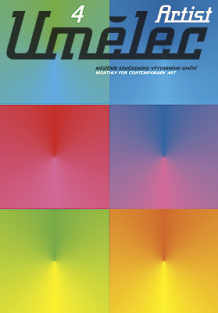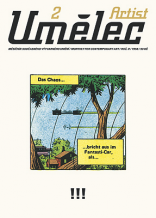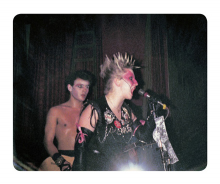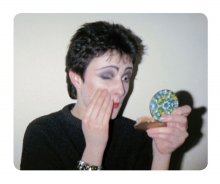| Revista Umělec 2010/1 >> Dirty Pictures---Rated XXX | Lista de todas las ediciones | ||||||||||||
|
|||||||||||||
Dirty Pictures---Rated XXXRevista Umělec 2010/101.01.2010 Tony Ozuna | záhlaví | en cs de |
|||||||||||||
|
I was once in a pseudo soft-porn movie, but just as an extra. It‘s called Blue Movie and of course it’s not Warhol’s film of the same name. It was a B-Movie that was never released: it didn’t even go straight to video—instead it went straight to oblivion. It was a seminal attempt to make a movie like Zack and Miri Make a Porno, but instead it had two college-aged male dolts instead of one (i.e. Zack), who in a financial fix try to make a killing by doing a sex film. My cameo has me standing in a “dirty” alley in Hollywood, and in line with a bunch of other guys (including some of my college room-mates from this time), fully-clothed but eager to be extras in the filming of a porno film. We all look seedy, but even more than that ridiculous, which might be why the film was never released to the public.
And in some ways, visiting the “The Porn Identity” exhibit on a Saturday afternoon at Kunsthalle Vienna was similar to this experience. The show was kind of subversive, since in its context at the MuseumsQuartier it has an allure but also that stain of reproach that is generally associated with porn. The main rooms were like a peep-show, meaning video monitors were placed at eye-level with lots of sex as well as Louisa Achilles’s “Naked Feminist,” with its selected/related interviews with ex-porn actresses (including Annie Sprinkle and Marilyn Chambers from the films Insatiable, and Behind the Green Door); there were also more artistic-experimental films (especially in gay porn), including scenes by Kenneth Anger and Jean Genet, and pioneering contemporary sex-scenes by dirty rascals like Ron Jeremy, Sachiko Hanai, Snoop Dogg, Bruce LaBruce, and Jack the Zipper. In all, the maze of videos was ultimately smut of both the highest and the lowest order, from the 1940s to the present. At its peaks (and not referring here to the countless views of erect penises), there are instances when the viewer was caught in traps of habit or expectation, and foiled at the hand of the artist. For instance, Johannes Wohnseifer’s tricky installation was right at the entrance: his “In Front of the Green Door,” (1996) was a green door, ajar and inside the room beyond the door, there was a porno movie on play: people, or at least men visiting the gallery naturally tried to open the door to go into the dark room (as if it were a video booth), but the door was stuck in place, so you could peep through the partially opened door, but it was forbidden to enter. The video was titled “Possesions” by the “erotic artist” film-maker Andrew Blake, with three women in an evening lesbian scene beside a pool in LA—where else? Eventually, the scenes of rampant copulation in close-up views especially scenes of penetration in all their glorious or colorful variation and some in utter outrageousness were just monotonous even boring, as is porn in general. Just as porn has its creative limitations to keep viewers attention, only a few of the works could break out of the ghetto that they were either a product of, were inspired by, or succumbed to by their incorporation in the exhibit. A recreation of Marcel Duchamp’s ready-made “Bicycle Wheel” (1913/2007) was seemingly a part of the exhibit, as something else to look at, besides the dirty pictures. There was one of the icy nude female sculptures from Stanley Kubrick’s Clockwork Orange, used in the Korova milk-bar scenes, though scenes from his last film, Eyes Wide Shut, would have been equally fitting. Overall, exploring the full scope of pornography’s impact on art, media and pop culture was the primary goal of the curators Thomas Edlinger, Angela Stief, and Florian Waldvogel. After all, consider Madonna, who has become nothing more than an overblown burlesque sex-show for the mainstream. Only a few video works, like Ellen Cantor’s “The Dictator and his Maid,” (2005) were able to transcend the porn-ghetto, by appearing to be a typical Nazi-master and servant affair then turning into a hypnotic ritual of charged mutual seduction. Beyond this, The Rainbow Wall was a collective effort by the curators, and essentially it was a wall of 25 video screens—five high and five across, with identical scenes shown in a colorful choreography, meaning it showed five scenes at a time, but the scene appeared in a vertical row. Side-by-side, the scenes were like a porn mash-up, placing shots of Betty Page beside hard-core homo and hetero-banging, in chic interiors both cheesy and bizarre. In a film review of Zack and Miri Make a Porno, by Steffen Silvis, the former (and legendary) Prague Post reviewer likens porn to “merely carnal wallpaper for ill-lit rooms and lurid digs.” And this best describes the Rainbow Wall and The Porn Identity, in general: carnal wallpaper for a gallery. Finally, here is a secret to younger, struggling artists: some of the most degenerate and yet aesthetically captivating scenes from 1970s porn classics like Behind the Green Door, Deep Throat, etc. have been a sacred cove of ugly-beauty inspiration and influence on successful contemporary artists since then, but it seems like even more so in the 90s to the present (from Mathew Barney to Vanessa Beecroft). After all, porn is just a business, and for some of the most successful artists today, so is their art. 901 Credits: 12) Edward Kienholz und Nancy Reddin Kienholz, The Bronze Pinball Machine with Woman Affixed Also, 1980, Exemplar 1 von 3, Courtesy Berlinische Galerie - Landesmuseum für Moderne Kunst, Fotografie und Architektur © Foto: Nancy Reddin Kienholz + Bruce LaBruce, Skin Gang, 1999, Courtesy of Cazzo Film, Berlin © photo: Stephan Wyckoff; Kunsthalle Wien, 2009 14) “Rainbow Wall”, exhibition view “The Porn Identity. Expeditionen in die Dunkelzone” Kunsthalle Wien © photo: Stephan Wyckoff; Kunsthalle Wien, 2009
01.01.2010
Artículos recomendados
|
|||||||||||||
|
04.02.2020 10:17
Letošní 50. ročník Art Basel přilákal celkem 93 000 návštěvníků a sběratelů z 80 zemí světa. 290 prémiových galerií představilo umělecká díla od počátku 20. století až po současnost. Hlavní sektor přehlídky, tradičně v prvním patře výstavního prostoru, představil 232 předních galerií z celého světa nabízející umění nejvyšší kvality. Veletrh ukázal vzestupný trend prodeje prostřednictvím galerií jak soukromým sbírkám, tak i institucím. Kromě hlavního veletrhu stály za návštěvu i ty přidružené: Volta, Liste a Photo Basel, k tomu doprovodné programy a výstavy v místních institucích, které kvalitou daleko přesahují hranice města tj. Kunsthalle Basel, Kunstmuseum, Tinguely muzeum nebo Fondation Beyeler.
|






























 We Are Rising National Gallery For You! Go to Kyjov by Krásná Lípa no.37.
We Are Rising National Gallery For You! Go to Kyjov by Krásná Lípa no.37.
Comentarios
Actualmente no hay comentariosAgregar nuevo comentario